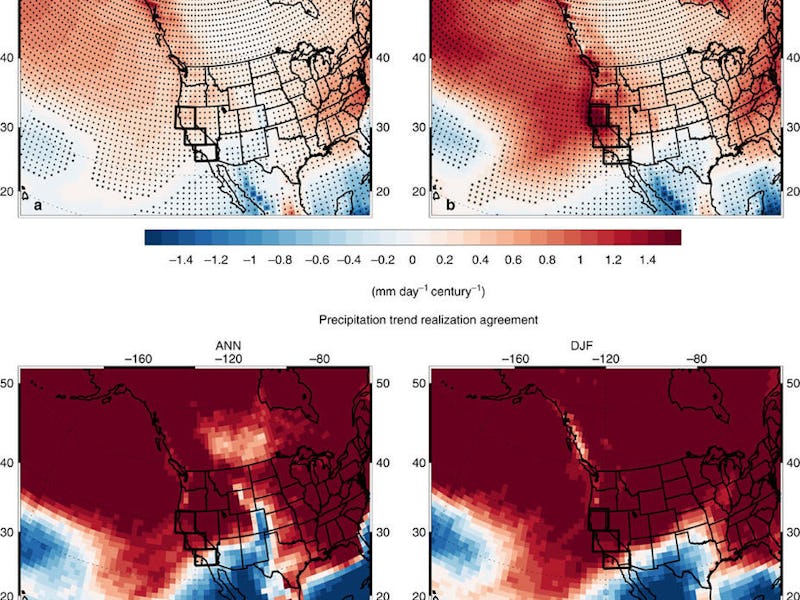Drought-Stricken California Will Be Covered In Rain by 2100
So much for the golden state.

As the recent California drought showed, climate change has the terrifying ability to turn farmland into dustbowls and forests into kindling. But new research has come to the surprising conclusion that climate change will make most of California a whole lot wetter by the end of this century, suggesting that the cause of the state’s drought woes may also be the cure.
The California drought, which lasted five years, was made about 15-20 percent worse by global warming, according to research published in 2015. All indications suggested that California’s future would only get hotter and drier, until now. The latest study, published Thursday in Nature Communications, suggests that, over the course of this century, climate change will drum up an effect similar to El Niño in the Pacific Ocean — which will drive warm, wet air over California, where it will fall as rain and snow.
Model projections suggest that most of the state will be about 15 percent wetter by the end of the century. The only exception is the southern tip of the state, which will get about three percent drier. Of course, these predictions are based on the assumption that the the world will fail to take meaningful action on reducing greenhouse gas emissions in coming decades.
Scientists at the University of California, Riverside predict California will get an average of 12 percent more precipitation through the end of this century compared to the last 20 years of last century.
“Ultimately, what I am arguing is El Niño-like years are going to become more the norm in California,” lead author Robert Allen, an Earth scientist at University of California, Riverside, says in a release.
Projections for wetter weather may sound great for a state that’s been starved for rain, but too much water can cause just as many issues. If California gets wetter, people, wildlife, and the landscape will need to adapt Some crops that used to work in certain regions may not be so great anymore. Floods and erosion could become more costly to deal with.
The model projects increased rain in red regions, and drier weather in blue regions.
The thing about climate change is that its outcomes are both hard to predict and unevenly distributed. Another recent study found that northern parts of the United States could actually stand to benefit economically from climate change thanks to longer growing seasons and milder winters, while the South pays a heavy price. In that analysis California’s fortunes fall somewhere in the middle, with most counties suffering moderately and a few benefitting slightly.
Abstract
Future California (CA) precipitation projections, including those from the most recent Climate Model Intercomparison Project (CMIP5), remain uncertain. This uncertainty is related to several factors, including relatively large internal climate variability, model shortcomings, and because CA lies within a transition zone, where mid-latitude regions are expected to become wetter and subtropical regions drier. Here, we use a multitude of models to show CA may receive more precipitation in the future under a business-as-usual scenario. The boreal winter season-when most of the CA precipitation increase occurs-is associated with robust changes in the mean circulation reminiscent of an El Niño teleconnection. Using idealized simulations with two different models, we further show that warming of tropical Pacific sea surface temperatures accounts for these changes. Models that better simulate the observed El Niño-CA precipitation teleconnection yield larger, and more consistent increases in CA precipitation through the twenty-first century.